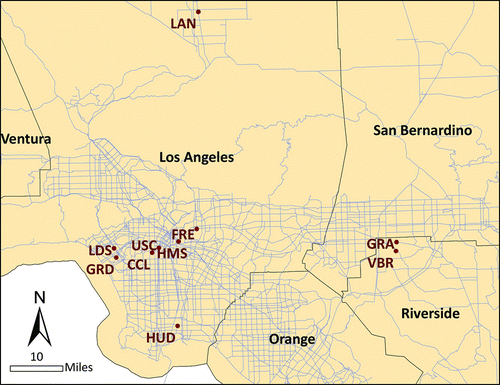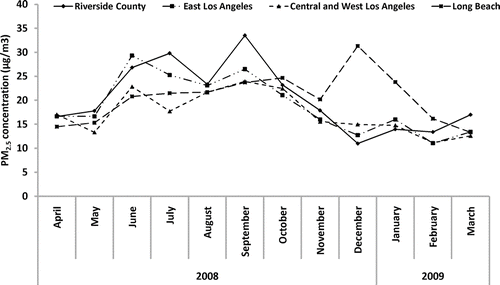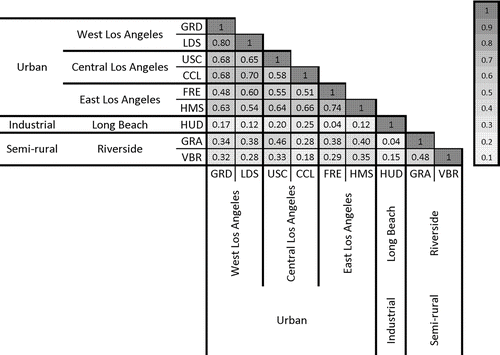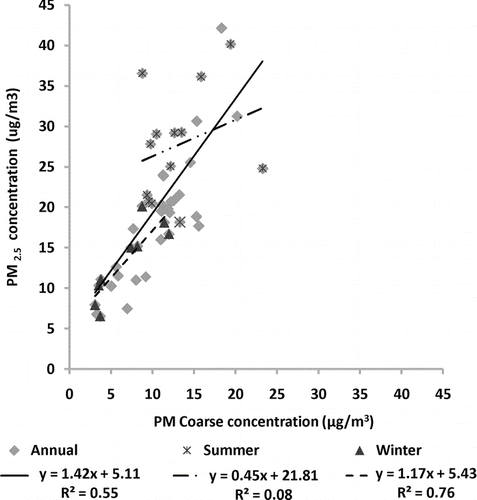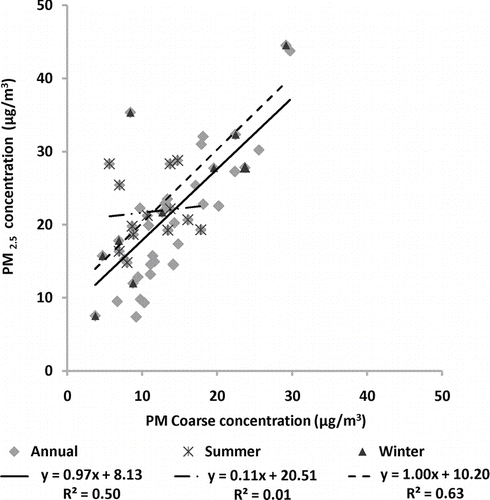Abstract
Recent epidemiological and toxicological studies suggest that coarse particulate matter (CPM, particles smaller than 10 and larger than 2.5 μm in diameter, PM 10−2.5 ) concentrations may be associated with adverse health outcomes at levels similar to or larger than those associated with PM 2.5 concentrations. CPM may consist of several, mechanically generated, potentially toxic components, including re-suspended road dust, industrial materials, trace metals, and bio-aerosols. In an effort to better understand and quantify the linkage between sources, composition and the toxicity of coarse PM, 10 sampling sites were set-up in the Los Angeles area. Sites within this diverse monitoring network were selected to encompass urban, rural, coastal, inland, near-freeway, community-based, upwind pollutant “source” and downwind pollutant “receptor” sites to fully characterize the range of likely conditions. At each location, a 24 h time-integrated coarse PM sample was collected once per week for one year in order to assess the seasonal and spatial patterns in coarse PM concentrations. Annual geometric mean CPM mass concentrations varied from <5.0 μg/m 3 to approximately 12 μg/m 3 . Concentrations were 2–4 times higher in the summer than the winter. CPM correlations between sites in close proximity to each other tended to be high (r 2 > 0.80), but were poor between urban center and inland sites. The coefficients of divergence (COD) were also calculated across all site pairs to quantify CPM mass concentration spatial heterogeneity. The CODs (most monthly median values >0.2) suggest modest heterogeneity overall, but the CODs calculated between the urban core site pairs were homogeneous.
1. Introduction
National particulate matter (PM) standards have evolved over the years as PM10 (particles smaller than 10 μ m in diameter) replaced TSP (Total Suspended Particulate) in 1987 and PM2.5 (particles smaller than 2.5 μ m in diameter) was added in 1997. The standards changed as numerous epidemiological and toxicological studies linked elevated airborne PM mass concentration of size fractions ranging from ultrafine-to fine-to coarse, to a variety of adverse health outcomes including both respiratory and cardiac diseases (CitationBecker et al. 2005; CitationHornberg et al. 1998; CitationKleinman et al. 2003; CitationLi et al. 2003; CitationLipsett et al. 2006; CitationMonn and Becker 1999; CitationOberdorster 2001; CitationPekkanen et al. 1997; CitationVilleneuve et al. 2003; CitationXia et al. 2004; CitationYeatts et al. 2007). PM10 consists of both fine (PM2.5) and coarse (PM10−2.5—smaller than 10 μ m in diameter but larger than 2.5 μ m, CPM) fractions of airborne particulate matter and therefore control of both PM2.5 and CPM concentrations is required to meet PM10 standards. These two PM size fractions can have substantially different sources and sinks. Therefore, the two fractions can be composed of varying chemical species contributing to potentially different health outcomes. Fine particles are known to primarily originate from combustion processes and from gas-to-particle conversion processes in the atmosphere. Coarse particles, on the other hand, arise predominantly from mechanical processes including—but not limited to—brake lining abrasion, tire wear, windblown soil and dust, sea salt and bioaerosols such as pollen and fungal spores (CitationAlmeida et al. 2005; CitationChow et al. 1994; CitationEdgerton et al. 2009; CitationHarrison et al. 1997; CitationHinds 1999).
Abundant ambient PM2.5 mass concentration data are available world-wide through long-term regulatory monitoring networks and special studies (CitationMotallebi et al. 2003; CitationPinto et al. 2004). However, CPM mass concentration data are only available on a much more limited scale and hence significantly less is quantitatively known about spatial and seasonal characteristics of coarse particles.
Although data are limited, a review of PM studies showed that CPM mass concentration correlations among sites in some urban areas were lower than for accompanying PM2.5 (CitationWilson et al. 2005), although PM10 and PM2.5 concentrations themselves can be well correlated in the Los Angeles area (CitationMotallebi et al. 2003; CitationTurner and Allen 2008; CitationWilson et al. 2005). In rural areas the contribution of windblown dust to overall CPM mass concentrations dominated, while in urban areas the particles associated with motor vehicle operation are more important. Consequently, in urban areas traffic volume, traffic speed, and distance from the road can strongly influence the overall CPM mass concentrations (CitationHarrison et al. 2004; CitationLianou et al. 2007). Local meteorology is clearly also important.
In many epidemiological studies, central monitoring site data are used as a surrogate for population exposure to pollutants. Since CPM concentrations may vary widely in a given region (CitationWilson et al. 2005), this traditional method may not represent true population exposure (CitationBrunekreef and Forsberg 2005; CitationMonn 2001; CitationWilson et al. 2005) and could result in exposure misclassification. Therefore, it is important to study ambient CPM concentrations using a dense network of sites in multiple locations in order to understand the relationship between coarse PM mass concentrations, sources, sinks, and their spatial and temporal variability. Here the first results from a network of 10 CPM sampling sites in distinctly different regions of the Los Angeles area, encompassing rural-agricultural, urban, and industrial sites are reported. We focus on the temporal and spatial variation of 24 h time-integrated daily mean coarse particle mass concentrations obtained weekly for an entire year. A companion paper reports the spatial and temporal variability of near-continuous hourly CPM mass concentrations at a subset of these sites (Moore et al. 2009). These studies, in conjunction with a later evaluation of the chemical composition and toxicological properties of the CPM (currently underway), will improve our understanding of the relationship between CPM concentrations and exposure. This will help the regulatory community develop improved strategies to protect the public from the adverse effects of CPM.
2. METHODOLOGY
2.1. Site Selection and Meteorology
The site selection criteria were designed to include and represent the diversity of CPM sources and sinks in greater Los Angeles. Consequently, the 10 sites () selected include near-freeway, community (e.g., non-freeway), semi-rural, and desert sites (). The sites may have more than one of these attributes and it is important to recognize that all sites are in reasonable proximity to roadways and thus have some potential to be impacted by motor vehicle traffic. It is useful to separate the sites geographically into Riverside County; Long Beach; eastern, central, and western Los Angeles and Lancaster.
TABLE 1 Site information including sampling area, the designation code, description, geographic co-ordinates, site elevation, sampling period and data recovery
Both Riverside county sites (GRA and VBR) are located about 80 km inland from downtown Los Angeles in the pollutant “receptor” area of the inland Los Angeles Basin (LAB). Both are located in residential areas of a semi-rural nature. However, GRA is immediately to the North of CA-60 and may be strongly impacted by freeway traffic, while VBR is not as close to CA-60, although it is adjacent to significant surface roadways.
By contrast, the Long Beach site (HUD) is located in a mixed residential/commercial neighborhood approximately 2 km inland from the Ports of Los Angeles and Long Beach. The site is immediately to the east of the Terminal Island Freeway (SR-103) and 1.2 km west of the I-710. Both of these freeways have a high fraction and volume of heavy duty diesel vehicles in Port service. The Long Beach site is in a pollutant “source” region of the LAB.
Both of the eastern Los Angeles sites (HMS and FRE) are in close proximity to major freeways (). The centrally located University of Southern California (USC) site is a typical urban site in downtown Los Angeles, within 130 meters of I-110. Numerous studies have been conducted at this site(CitationMoore et al. 2007; CitationNing et al. 2007; CitationSardar et al. 2005). The CCL site is slightly west of the USC site and is located in South Central LA in a residential community adjacent to surface streets with significant motor vehicle traffic. The two western Los Angeles sites (GRD and LDS) can be classified as coastal sites, although LDS is immediately to the southwest of the I-405 freeway. The desert site (LAN) is in the Antelope Valley, north of the LAB. This site is in the city of Lancaster and is desert-dominated, although the area around the site is increasingly suburban. The LAN site is over 2 km from the nearest freeway, although it is near locally significant surface arterial roadways.
Continuous meteorological data are not available at all sites. Briefly, meteorological conditions in the Los Angeles air basin are generally stable with light winds throughout the year, with some diurnal and season variations (ARB 1992; NOAA 1999). The diurnal temperature change is muted and the annual mean daily high is 25°C and the low is 15°C (NOAA 1999). In the inland regions (e.g., Riverside) and in the mountains (e.g., LAN), the temperature variability is higher than at the coast. The surface wind field throughout the year is characterized by calm or near calm winds predominantly from the N/NE overnight and into the early morning. During the morning, an onshore or sea breeze wind develops (predominantly from the SW in the coastal areas and W inland) and, while remaining relatively light, wind speeds peak in the afternoon. In the early evening, the wind speed starts to fall and the onshore breeze starts to shift to the overnight return flow. This pattern is relatively robust throughout the year, although the fall and winter are associated with more calm periods overnight, and weaker wind speeds during the day (Moore et al. 2009a). During the fall and winter, this stable pattern can be disrupted by the occasional warm, dry off-shore wind events known locally as “Santa Ana” winds. Santa Ana conditions present typically strong winds from the N/NE throughout the air basin (ARB 1992). The limited meteorological data available for this study are consistent with this description (data are presented in the companion article, CitationMoore et al. 2010).
2.2. Sampling Period and Frequency
Sampling was conducted weekly at the 10 sites from April 2008–March 2009 to capture seasonal trends. Once per week, a 24 h time-integrated CPM sample (described below) was collected at each site. Data recovery at each site was excellent () and was over 88% overall. For logistical reasons, the regular weekly CPM samples were obtained from 12:00 AM PST to 12:00 PM PST on weekdays. All completed CPM samples were removed from the samplers within 24 h and returned to USC for weighing.
2.3. Sampling Equipment and Sample Screening
Coarse Particulate Matter Samplers
At each site dual Personal Cascade Impactor Samplers (Sioutas™ PCIS, SKC Inc., Eighty Four, PA, USA), were used to collect particles greater than 2.5 μ m, 2.5 μ m–0.25 μ m, and less than 0.25 μ m at 9 liters per minute (LPM) downstream of an inlet designed to achieve the PM10 cutpoint (CitationMisra et al. 2002; CitationSingh et al. 2003). The PM10 inlet used for the two PCIS is described by CitationMisra et al. (2003). Teflon (25 and 37 mm, Zefluor™, 0.5 μ m pore size, Pall Corp, East Hills, NY) substrates were used and all PCIS-derived mass concentration data reported here are based upon the Teflon measurements.
At LAN, evidence suggested substantial particle bounce occurred between stages in the PCIS consistent with the very low RH observed at this site (discussed in the companion article, Moore et al. 2009) (CitationRao and Whitby 1977; CitationWinkler 1973). Therefore at LAN, the CPM mass concentrations were reported using concurrent data collected by the USC Coarse Particle Concentrator (CitationKim et al. 2001; CitationMisra et al. 2001). The Coarse Particle Concentrator is composed of a virtual impactor upstream of a stainless steel filter holder. In this application, the virtual impactor is operated at a total flow rate of ca. 50 LPM and a minor flow rate of ca. 2 LPM. Operated downstream of an inlet designed to achieve the PM10 cutpoint (similar to the inlet used for PCIS), particles between ca. 2.4–10 μ m are relatively concentrated by a factor of approximately 25 and collected on the downstream Teflon filter (47 mm, Teflo™, 2.0 μ m pore size, Pall Corp, East Hills, NY). These units are described in greater detail by (CitationMisra et al. 2001) and are now commercially available (Continuous Particulate TEOM Monitor, Series 1405, Thermo Fisher Scientific Inc. Waltham, MA).
The CPM mass concentrations measured by the USC Coarse Particle Concentrator and the PCIS coarse fraction were compared for validation at all the sites. With the exception of the LAN site, at which the USC Coarse Particle Concentrator measured on average about 50% higher CPM concentrations, the agreement between CPM mass concentration measurements made by both methods was typically within 20% or less (the average USC Coarse Particle Concentrator to PCIS CPM concentration was 1.15 (± 0.11), as shown in Figure S-4 of the Supplement). All mass concentration data reported here are from the PCIS with the exception of the LAN data.
All filter substrates were weighed before and after sampling to determine the collected CPM mass. The filters were equilibrated for 24 h in a room with controlled relative humidity (30% ± 5%) and temperature (21°C ± 2°C) before weighing using a microbalance (Model MT 5, Mettler-Toledo Inc., Highstown, NJ). Consecutive mass measurements within 3 μ g were considered “stable.” In the field, sampler flow rates were checked before and after sample collection. Samples with flow rates that varied more than 5% from the nominal value were discarded.
3. RESULTS AND DISCUSSION
3.1. Temporal and Spatial Variations
As described earlier, it is convenient to group the sampling sites into geographic groups—three clusters for West (LDS and GRD), Central (USC and CCL) and East Los Angeles (FRE and HMS), and Riverside County (GRA and VBR). The Lancaster (LAN) and Long Beach (HUD) sites are assessed separately. shows a summary of CPM mass concentration data and statistics for the study, including geometric and arithmetic means and standard deviations at each site.
TABLE 2 Summary of statistics for the coarse particles mass concentrations (μ g/m3) at each sampling site
The annual geometric mean concentrations observed across all 10 sites are very similar with the exception of LAN which is about half (ca. 5 μ g/m3) of the rest of the values (ca. 10 μ g/m3). CPM concentrations at LAN were consistently lower than at the other sites and seasonal variation at this site is muted. In contrast, summer CPM mass concentrations were 2–4 times greater than the winter concentrations at most sites. CPM mass concentrations at the HUD site were the exception where concentrations in the summer were typically lower than in the winter. HUD is directly affected by port activities and high heavy duty truck traffic, neither have a substantial seasonal variation (Moore et al. 2009); however elevated concentrations in winter might be due to lower atmospheric mixing height. The two Riverside sites had the largest change from winter to summer CPM mass concentrations (). CPM concentrations at the USC were consistent with prior studies (14.6 to 24.0 μ g/m3) (CitationSardar et al. 2005).
shows the seasonal variations of monthly average CPM concentrations by cluster/site. As described above, a characteristic seasonal variation can be observed at most sites with relatively elevated CPM concentrations observed in the warmer seasons peaking in August and September. This is consistent with the earlier California study that showed the CPM fraction dominates total PM10 concentrations during the summer in California (CitationMotallebi et al. 2003). Higher summertime CPM concentrations can be attributed to elevated wind speed that enhances wind induced re-suspended CPM concentrations. Wind speeds are higher in the summer, in general (see section 2.0 and the companion article, Moore et al. 2010). Harrison and colleagues also showed a similar seasonal pattern in Birmingham, UK with lower concentrations during winter which was attributed to increased precipitation and higher relative humidity (CitationHarrison et al. 2001). A somewhat similar pattern—if reduced in magnitude—was observed at Lancaster, but a very different one is observed in Long Beach. In Long Beach, peak cargo traffic typically occurs in the fall of each year (Moore et al. 2009a). Higher port activity coupled with the lower mixing height in the fall (discussed above) may produce these higher Long Beach CPM concentrations.
FIG. 2 Average monthly coarse PM concentrations in three site clusters and Long Beach and Lancaster sites.
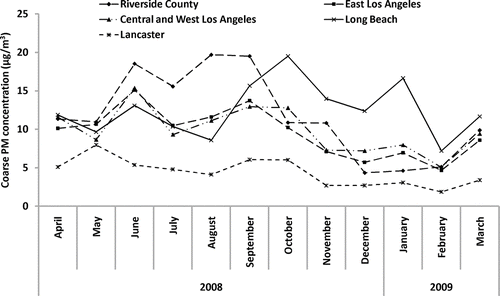
Temporal variations in PM2.5 concentrations are shown in (Lancaster is not shown due to the lack of available data). The PM2.5 concentrations vary less seasonally compared to CPM mass concentrations. This has been observed previously in the Los Angeles area (CitationPinto et al. 2004; CitationWilson et al. 2005). The primary direct source for PM2.5—motor-vehicle emissions—in the LAB is not directly affected by seasons. In contrast, secondary atmospheric formation of fine particles through photochemical processes is higher during the summer (relatively higher concentrations are observed from May–October). Stronger source strength in the summer however is counterbalanced by the lower mixing height in winter months thus dampening seasonal variability. The Long Beach site, as previously described, is located in a pollutant “source” region of Los Angeles and shows different seasonal trends for both PM2.5 and CPM mass concentrations. Similarly to the CPM concentrations, high winter PM2.5 concentrations may be due to pollutant build-up due to decreased atmospheric ventilation. The ratio of PM2.5 to PM10 at these sites varied modestly throughout the year (approximately 0.6) with little discernible seasonal trend. CPM mass concentrations show more variability and are generally lower than PM2.5 mass concentrations across the monitoring network, which is consistent with the more heterogeneous sources and stronger atmospheric removal processes associated with CPM.
CPM concentration correlations between different sites/clusters yield interesting observations about the temporal variability of mass concentrations between sites. shows the site-by-site correlation contour plot. Strong correlations are observed between the urban sites in Los Angeles, particularly among sites in western and central Los Angeles.
The two coastal sites (LDS and GRD) showed very good correlation (r2 = 0.80, ) throughout the year. Moving inland, both USC and CCL sites, located in central Los Angeles, show strong correlations with other urban sites located in Los Angeles, whereas their correlations with east Los Angeles sites become relatively lower (). Even over the relatively small distances between the central and eastern Los Angeles sites—subject to very similar sources—differences in source strength and intensity can limit predictability. Correlations between the Los Angeles cluster of sites and sites in Riverside County were generally poor ().
Although the VBR and GRA sites are less than 3 km apart, the relatively weak correlation between the two Riverside County sites (r2 = 0.46) suggest different sources of coarse particles or source strengths at these locations. As discussed previously, GRA is located close to the CA-60 freeway and may be disproportionately affected by resuspended CPM from vehicular traffic. In contrast, VBR is located 3 km south (i.e., mostly upwind) of the CA-60 and may also be affected by windblown dust (from agricultural fields, CitationSardar et al. 2005).
CPM correlations in Long Beach are different than observed elsewhere. Very little correlation is seen between HUD and the other sites (). This is a “source” region for pollutants in Los Angeles, as discussed previously, and it has been observed elsewhere that a higher particle resuspension rates are associated with HDDVs compared to light duty vehicles (CitationCharron and Harrison 2005). Heavy duty vehicles also have higher brake-wear emission rates than light duty vehicles due to stronger abrasion processes. Both of these factors together can result in higher emission rates of coarse particles (CitationGarg et al. 2000). There may also be a different intensity and proximity to industrial CPM sources near the Long Beach site.
3.2. Comparison of PM2.5 and CPM Concentrations and Relationships
Selected comparisons between annual, winter and summer CPM and PM2.5 concentrations are shown in , , , (similar figures for additional sites are included in the supplement; Figures S-1–S-3). Across all of the sites shown, winter-time correlations (up to r2 = 0.80) are much higher than the summer correlations (most r2 values are less than 0.10). Only at FRE—and at LAN where no data are available—is the winter correlations relatively poor (r2 = 0.36). The moderate annual correlation is driven by the high correlation coefficients observed in the winter. In Riverside (), the poor summertime correlation suggests how the relative importance of homogeneous (e.g., atmospheric processing of PM2.5) and heterogeneous (e.g., wind-driven coarse PM) to atmospheric PM concentrations can vary throughout the year. The lack of correlation in the summer may be driven by the strong impact of atmospheric photochemistry on PM2.5 emissions, while not affecting CPM concentrations. The relatively good correlation in the winter (e.g., in Riverside at GRA and VBR, r2 = 0.73 and 0.77, respectively) may be due to reduced photochemistry coupled with the lower boundary layer and more calm conditions, thus enhancing the contribution of traffic sources to both PM fractions.
FIG. 5 Annual and seasonal correlations between PM2.5 and CPM in Riverside County cluster GRA. Data shown are from April 2008–March 2009.
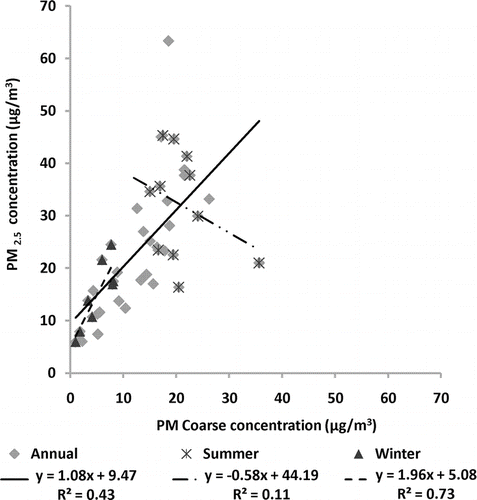
A similar trend was observed in the urban sites located in Los Angeles County ( and ). While PM2.5 and CPM mass concentrations show a strong correlation in winter, significantly weaker correlations are seen in summer months. The r2 correlation coefficients in summer range from 0.01 to 0.30 which indicate very low or no correlation between PM2.5 and PM10, while in winter r2 values observed were higher than 0.66 (with exception of “FRE,” r2 = 0.36). The urban sites are in close proximity to relatively strong vehicular sources of primary PM2.5 and CPM. The lower summer correlations at the sites in closer proximity of major roads (“LDS,” “CCL,” and “HMS”) and relatively higher winter time correlations at these sites emphasize the more dominant role of vehicle traffic on particle concentrations in this urban area. The differences in winter and summer correlations can be seen in the Long Beach site as well. We attribute these differences to the higher influence of wind-induced resuspension of CPM in summer compared to the resuspension of road dust by traffic in wintertime. Chemical composition data, currently under way, will provide more insight into the factors driving these differences.
FIG. 6 Annual and seasonal correlations between PM2.5 and CPM in Los Angeles and West Los Angeles clusters (a) GRD and (b) CCL. Data from April 2008–March 2009.
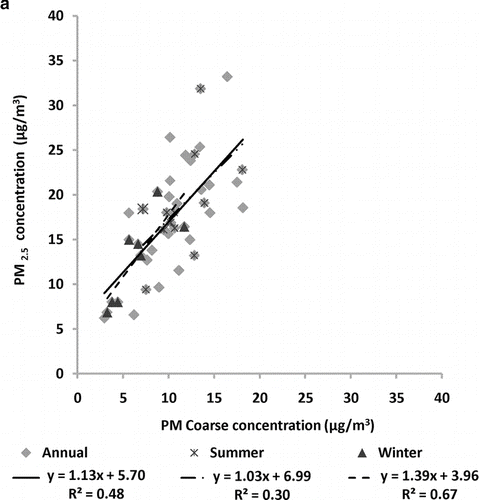
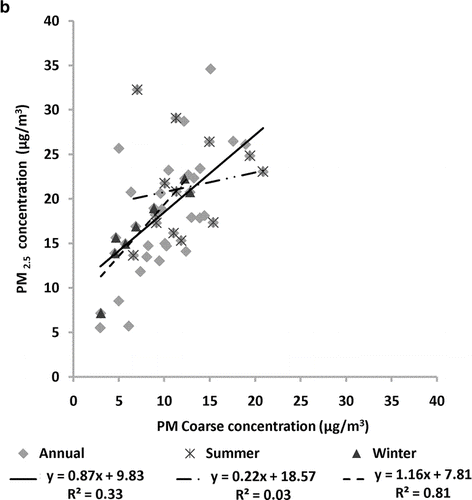
3.3. Coefficients of Divergence (COD) Calculations for CPM Mass Concentrations
In a review on intraurban variability of PM mass concentrations, Wilson and colleagues suggest using coefficient of divergence (COD) in conjunction with correlation coefficients and PM concentration data to better characterize intraurban variability (CitationWilson et al. 2005). High/low temporal correlation and high/low spatial homogeneity do not necessarily correspond (CitationTurner and Allen 2008) so evaluating both parameters are warranted. The COD is defined as:
FIG. 9 Coefficients of divergence for coarse PM concentrations calculated across all sites pairs (with the exception of the Lancaster site) by month for the entire study (April 2008–March 2009). Whisker-box plot shows minimum, 1st quartile, median, 3rd quartile, and maximum values.
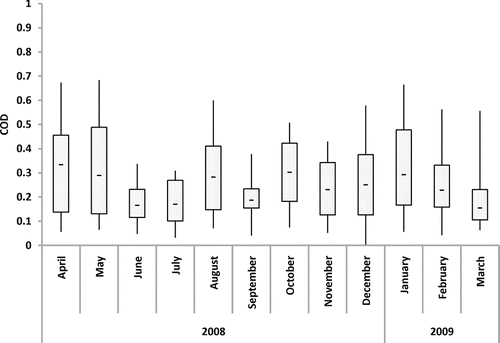
FIG. 10 Coefficients of divergence for coarse PM concentrations calculated across all urban site pairs (USC, CCL, FRE, HMS, GRD, and LDS) by month for the entire study (April 2008–March 2009). Whisker-box plot as described previously.
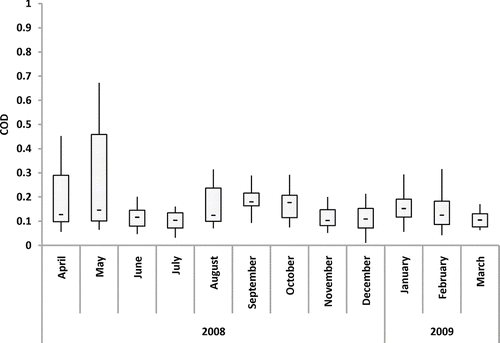
There are important caveats to the results reported here. While the CPM mass concentration data can usefully be interpreted within the framework used to determine the location of the sites (e.g., near-freeway vs. community), we acknowledge that it is not possible to quantitatively apportion the observed CPM concentrations between different sources. This is the first of several papers reporting the results from the comprehensive study of CPM in the Los Angeles area. Further, the time-integrated samples reported here may well average over significant diurnal differences in concentrations that may be relevant to acute exposures (Moore et al. 2009b). As the chemical composition and toxicological data become available, it will be useful to interpret those data within the context of the material reported herein.
4. CONCLUSIONS AND SUMMARY
This study focuses on ambient coarse PM mass concentrations, and the relationships between CPM and PM2.5 mass concentrations at 10 distinctly different locations in the Los Angeles region. The significant differences in concentrations and seasonal patterns showing the similarities and differences between coarse particle concentrations illustrate the influence of local sources on observations. The CPM mass concentrations observed are consistent with those reported previously in the Los Angeles area.
High correlations were observed between PM2.5 and CPM near major roads, where the dominant source of coarse particles is traffic induced resuspended particulate matter. A different behavior is observed in more rural areas, where windblown dust is a significant contributor to overall coarse particle concentrations, although even relatively rural sites in the Los Angeles are impacted by motor vehicle–related coarse PM concentrations as well. Correlation of CPM and PM2.5 concentrations are much higher during winter than summer. For the year of sampling, the average median COD of 0.24 complements the paired correlation coefficients showing modest heterogeneity of CPM in Los Angeles basin. We acknowledge that using 24 h time-integrated samples may obscure a potentially (and likely) higher variability observed during specific time periods of the day (discussed at length in the companion paper).
This research will help to better understand the sources and behavior of coarse particles in a primarily urban and motor-vehicle–dominated environment. There is clear evidence supporting the strong impact of road traffic activity on ambient coarse particle concentrations. While the chemical and toxicological analyses of these samples (currently underway) will provide insight into the specific sources of coarse PM, our observations nonetheless highlight the degree of variability even in 24 h time-integrated mass concentrations, which suggests that further work specifically targeting coarse PM emission sources is warranted.
uast_a_475472_sup_13610537.zip
Download Zip (322.7 KB)Acknowledgments
[Supplementary materials are available for this article. Go to the publisher's online edition of Aerosol Science and Technology to view the free supplementary files.]
This work was supported by the U.S. Environmental Protection Agency (STAR award #RD833743) and MESA Air grant #RD831697. The authors would like to thank the contribution of USC Aerosol Lab (A. Polidori, M. Arhami, Z. Ning, N. Hudda, K. L. Cheung), Suresh Thurairatnam, Ed Avol, Antelope Valley Air Quality Management District, the South Coast Air Quality Management District, St. Cecilias Church, Granite Hill Elementary School, Fremont Elementary School, LAUSD and Hollenbeck Middle School, St. Gerards Church and Church of Jesus Christ of Latter-Day Saints. This article has not been subjected to the EPA's peer and policy review and therefore does not necessarily reflect the view of EPA agency.
Notes
*Height relative to the ground.
aGeometric mean.
bArithmetic mean.
cStandard deviation.
dWinter = December-February.
eSummer = June-August.
REFERENCES
- Almeida , S. M. , Pio , C. A. , Freitas , M. C. , Reis , M. A. and Trancoso , M. A. 2005 . Source Apportionment of Fine and Coarse Particulate Matter in a Sub-Urban Area at the Western European Coast . Atmos. Environ. , 39 : 3127 – 3138 .
- Becker , S. , Dailey , L. A. , Soukup , J. M. , Grambow , S. C. , Devlin , R. B. and Huang , Y. C. T. 2005 . Seasonal Variations in Air Pollution Particle-Induced Inflammatory Mediator Release and Oxidative Stress . Environ. Health. Persp. , 113 : 1032 – 1038 .
- Brunekreef , B. and Forsberg , B. 2005 . Epidemiological Evidence of Effects of Coarse Airborne Particles on Health . Eur. Respir. J , 26 : 309 – 318 .
- California Air Resources Board . 1992 . California Surface Wind Climatology, Aerometric Data Division
- Charron , A. and Harrison , R. M. 2005 . Fine (PM2.5) and Coarse (PM2.5–10) Particulate Matter on a Heavily Trafficked London Highway: Sources and processes . Environ. Sci. Technol. , 39 : 7768 – 7776 .
- Chow , J. C. , Watson , J. G. , Fujita , E. M. , Lu , Z. Q. , Lawson , D. R. and Ashbaugh , L. L. 1994 . Temporal and Spatial Variations of Pm(2.5) and Pm(10) Aerosol in the Southern California Air-Quality Study . Atmos. Environ. , 28 : 2061 – 2080 .
- Edgerton , E. S. , Casuccio , G. S. , Saylor , R. D. , Lersch , T. L. , Hartsell , B. E. , Jansen , J. J. and Hansen , D. A. 2009 . Measurements of OC and EC in Coarse Particulate Matter in the Southeastern United States . J. Air. Waste Manage. , 59 : 78 – 90 .
- Garg , B. D. , Cadle , S. H. , Mulawa , P. A. , Groblicki , P. J. , Laroo , C. and Parr , G. A. 2000 . Brake Wear Particulate Matter Emissions . Environ. Sci. Technol. , 34 : 4463 – 4469 .
- Harrison , R. M. , Deacon , A. R. , Jones , M. R. and Appleby , R. S. 1997 . Sources and Processes Affecting Concentrations of PM10 and PM2.5 Particulate Matter in Birmingham (UK) . Atmos. Environ. , 31 : 4103 – 4117 .
- Harrison , R. M. , Jones , A. M. and Barrowcliffe , R. 2004 . Field study of the Influence of Meteorological Factors and Traffic Volumes upon Suspended Particle Mass at Urban Roadside Sites of Differing Geometries . Atmos. Environ. , 38 : 6361 – 6369 .
- Harrison , R. M. , Yin , J. X. , Mark , D. , Stedman , J. , Appleby , R. S. , Booker , J. and Moorcroft , S. 2001 . Studies of the Coarse Particle (2.5–10 mu m) Component in UK Urban Atmospheres . Atmos. Environ. , 35 : 3667 – 3679 .
- Hinds , W. C. 1999 . Aerosol Technol.: Properties, Behavior, and Measurement of Airborne Particles , New York : Wiley .
- Hornberg , C. , Maciuleviciute , L. , Seemayer , N. H. and Kainka , E. 1998 . Induction of Sister Chromatid Exchanges (SCE) in Human Tracheal Epithelial Cells by the Fractions PM–10 and PM–2.5 of Airborne Particulates . Toxicol. Lett. , 96–7 : 215 – 220 .
- Kim , S. , Jaques , P. A. , Chang , M. C. , Froines , J. R. and Sioutas , C. 2001 . Versatile Aerosol Concentration Enrichment System (VACES) for Simultaneous In Vivo and In Vitro Evaluation of Toxic Effects of Ultrafine, Fine and Coarse Ambient Particles—Part I: Development and Laboratory Characterization . J. Aerosol Sci. , 32 : 1281 – 1297 .
- Kleinman , M. T. , Sioutas , C. , Chang , M. C. , Boere , A. J. F. and Cassee , F. R. 2003 . Ambient Fine and Coarse Particle Suppression of Alveolar Macrophage Functions . Toxicol. Lett. , 137 : 151 – 158 .
- Krudysz , M. , Moore , K. , Geller , M. , Sioutas , C. and Froines , J. 2009 . Intra-Community Spatial Variability of Particulate Matter Size Distributions in Southern California/Los Angeles . Atmos. Chem. Phys. , 9 : 1061 – 1075 .
- Li , N. , Sioutas , C. , Cho , A. , Schmitz , D. , Misra , C. , Sempf , J. , Wang , M. Y. , Oberley , T. , Froines , J. and Nel , A. 2003 . Ultrafine Particulate Pollutants Induce Oxidative Stress and Mitochondrial Damage . Environ. Health. Persp. , 111 : 455 – 460 .
- Lianou , M. , Chalbot , M. C. , Kotronarou , A. , Kavouras , I. G. , Karakatsani , A. , Katsouyanni , K. , Puustinnen , A. , Hameri , K. , Vallius , M. , Pekkanen , J. , Meddings , C. , Harrison , R. M. , Thomas , S. , Ayres , J. G. , ten Brink , H. , Kos , G. , Meliefste , K. , de Hartog , J. J. and Hoek , G. 2007 . Dependence of Home Outdoor Particulate Mass and Number Concentrations on Residential and Traffic Features in Urban Areas . J. Air. Waste Manage. , 57 : 1507 – 1517 .
- Lipsett , M. J. , Tsai , F. C. , Roger , L. , Woo , M. and Ostro , B. D. 2006 . Coarse Particles and Heart Rate Variability Among Older Adults with Coronary Artery Disease in the Coachella Valley, California . Environ. Health. Persp. , 114 : 1215 – 1220 .
- Misra , C. , Geller , M. D. , Shah , P. , Sioutas , C. and Solomon , P. A. 2001 . Development and Evaluation of a Continuous Coarse (PM10–PM2.5) Particle Monitor . J. Air. Waste Manage. , 51 : 1309 – 1317 .
- Misra , C. , Geller , M. D. , Sioutas , C. and Solomon , P. A. 2003 . Development and Evaluation of a PM10 Impactor-Inlet for a Continuous Coarse Particle Monitor . Aerosol Sci. Technol. , 37 : 271 – 281 .
- Misra , C. , Singh , M. , Shen , S. , Sioutas , C. and Hall , P. A. 2002 . Development and Evaluation of a Personal Cascade Impactor Sampler (PCIS) . J. Aerosol Sci. , 33 : 1027 – 1047 .
- Monn , C. 2001 . Exposure Assessment of Air Pollutants: a Review on Spatial Heterogeneity and Indoor/Outdoor/Personal Exposure to Suspended Particulate Matter, Nitrogen Dioxide and Ozone . Atmos. Environ. , 35 : 1 – 32 .
- Monn , C. and Becker , S. 1999 . Cytotoxicity and Induction of Proinflammatory Cytokines From Human Monocytes Exposed to Fine (PM2.5) and Coarse Particles (PM10–2.5) in Outdoor and Indoor Air . Toxicol. Appl. Pharm. , 155 : 245 – 252 .
- Moore , K. , Verma , V. , Minguillon , M. C. and Sioutas , C. 2010 . Inter- and Intra-Community Variability in Continuous Coarse Particulate Matter (PM10–2.5) Concentrations in the Los Angeles Area . Aerosol. Sci. Technol. , 44 : 526 – 541 .
- Moore , K. F. , Ning , Z. , Ntziachristos , L. , Schauer , J. J. and Sioutas , C. 2007 . Daily Variation in the Properties of Urban Ultrafine Aerosol—Part I: Physical Characterization and Volatility . Atmos. Environ. , 41 : 8633 – 8646 .
- Motallebi , N. , Taylor , C. A. and Croes , B. E. 2003 . Particulate Matter in California: Part 2—Spatial, Temporal, and Compositional Patterns of PM2.5, PM10–2.5, and PM10 . J. Air. Waste Manage. , 53 : 1517 – 1530 .
- 1999 . National Oceanic and Atmospheric Administration http://www.wrh.noaa.gov/lox/climate/climate_intro.php The Climate of Los Angeles, California
- Ning , Z. , Geller , M. D. , Moore , K. F. , Sheesley , R. , Schauer , J. J. and Sioutas , C. 2007 . Daily Variation in Chemical Characteristics of Urban Ultrafine Aerosols and Inference of their Sources . Environ. Sci. Technol. , 41 : 6000 – 6006 .
- Oberdorster , G. 2001 . Pulmonary Effects of Inhaled Ultrafine Particles . Int. Arch. Occ. Env. Hea. , 74 : 1 – 8 .
- Pekkanen , J. , Timonen , K. L. , Ruuskanen , J. , Reponen , A. and Mirme , A. 1997 . Effects of Ultrafine and Fine Particles in Urban Air on Peak Expiratory Flow Among Children with Asthmatic Symptoms . Environ. Res. , 74 : 24 – 33 .
- Pinto , J. P. , Lefohn , A. S. and Shadwick , D. S. 2004 . Spatial Variability of PM2.5 in Urban Areas in the United States . J. Air. Waste Manage. , 54 : 440 – 449 .
- Rao , A. K. and Whitby , K. B. 1977 . Non Ideal Collection Characteristics of Single Stage and Cascade Impactors . J. Indust. Hyg. Assoc. , 38 : 174 – 179 .
- Sardar , S. B. , Fine , P. M. and Sioutas , C. 2005 . Seasonal and Spatial Variability of the Size-Resolved Chemical Composition of Particulate Matter (PM10) in the Los Angeles Basin . J. Geophys. Res.–Atmos. , 110
- Singh , M. , Misra , C. and Sioutas , C. 2003 . Field Evaluation of a Personal Cascade Impactor Sampler (PCIS) . Atmos. Environ. , 37 : 4781 – 4793 .
- Turner , J. R. and Allen , D. T. 2008 . Transport of Atmospheric Fine Particulate Matter: Part 2—Findings from Recent Field Programs on the Intraurban Variability in fine Particulate Matter . J. Air. Waste Manage. , 58 : 196 – 215 .
- Villeneuve , P. J. , Burnett , R. T. , Shi , Y. L. , Krewski , D. , Goldberg , M. S. , Hertzman , C. , Chen , Y. and Brook , J. 2003 . A Time-Series Study of Air Pollution, Socioeconomic Status, and Mortality in Vancouver, Canada . J. Expo. Anal. Env. Epid. , 13 : 427 – 435 .
- Wilson , J. G. , Kingham , S. , Pearce , J. and Sturman , A. P. 2005 . A Review of Intraurban Variations in Particulate Air Pollution: Implications for Epidemiological Research . Atmos. Environ. , 39 : 6444 – 6462 .
- Winkler , P. 1973 . Relative Humidity and the Adhesion of Atmospheric Particles to the Plates of Impactors . Aerosol Sci. , 5 : 235 240
- Xia , T. , Korge , P. , Weiss , J. N. , Li , N. , Venkatesen , M. I. , Sioutas , C. and Nel , A. 2004 . Quinones and Aromatic Chemical Compounds in Particulate Matter Induce Mitochondrial Dysfunction: Implications for Ultrafine Particle Toxicity . Environ. Health. Persp. , 112 : 1347 – 1358 .
- Yeatts , K. , Svendsen , E. , Creason , J. , Alexis , N. , Herbst , M. , Scott , J. , Kupper , L. , Williams , R. , Neas , L. , Cascio , W. , Devlin , R. B. and Peden , D. B. 2007 . Coarse Particulate Matter (PM2.5–10) Affects Heart Rate Variability, Blood Lipids, and Circulating Eosinophils in Adults with Asthma . Environ. Health. Persp. , 115 : 709 – 714 .
